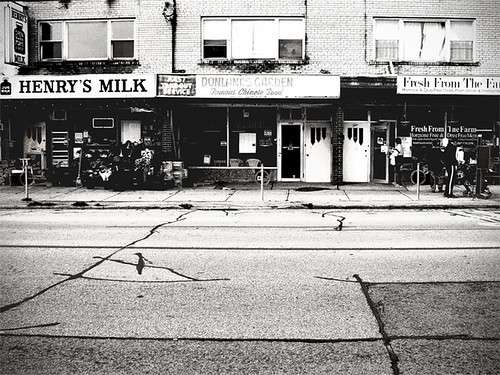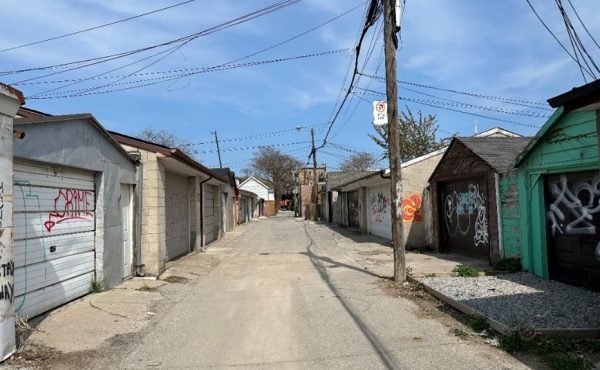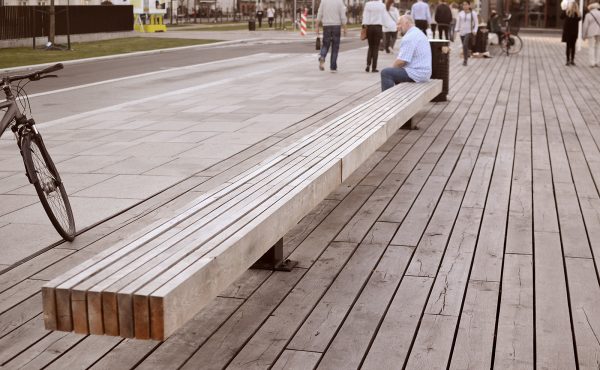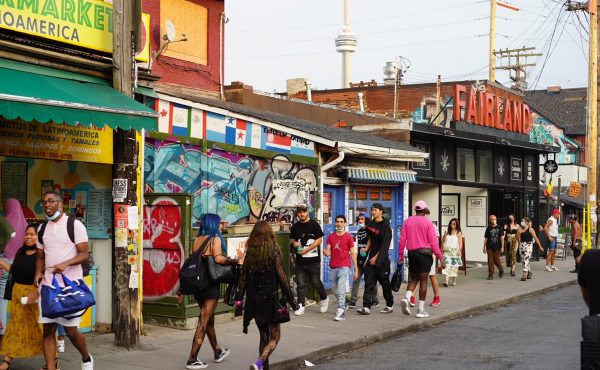
Ed: During the Walk 21 conference a few of us had the all too brief pleasure to meet James Rojas from Los Angeles. After he returned to LA he sent us an email with his impressions of Toronto that, I think, get to heart of this city’s general aesthetic: messy urbanism. It’s a difficult concept to accept — most people have an idea of a beautiful city that looks something like Paris or some other city with a continuous urban form — but it may be a key part of why Toronto is such an exciting place to be. And of course, it’s always wonderful to hear an outsider take on the place you live in — where you might tend fret over some of the details — especially when it’s glowing.
I spent last week in Toronto and fell in love with what I will call its messy urbanism. The city contains the usual suspects on the menu of elements of contemporary good urban form: mixed-use, bike paths, transit, street trees, etc. However, there’s a sort of less-than-manicured quality to the whole thing, and coupled with a huge diversity of people, the city ends up feeling gloriously messy, in a functional and walkable way.
The city’s messiness and realness stands in refreshing contrast to oft-cited beacons of “smart growth” and good urban design, such as San Fransisco and Boston, where the perfection of the built form has almost transformed these cities into museums. In Toronto, rickety and ramshackle Victorian buildings sit snugly next to sleek modern 20-story condos. Tree-lined streets of row houses (some restored, many not) run right into bustling commercial boulevards filled with streetcars, bicyclists, traffic, produce vendors.
The end result is that Toronto is a great city to roam around in and explore. The city’s street grid and generous sidewalks provide the urban explorer like me with ample opportunity to get lost, discover new spaces in the process, and then make my way back to where I was headed in the first place. The blocks are small, the streets narrow (jaywalking is a snap!); the city is relatively flat; the architecture is varied — from the massive to the very fine-grained. Many of the Toronto’s downtown streets are broken up by sweeping vistas of great pieces of architecture, such as the university buildings and churches. Distinct neighborhoods abound, each with its own host of unique spots and spaces to discover.
The following is a run-down of what elements I thought seemed to make Toronto fantastically urban and messy all at the same time.
Bicycles abound!
Bikes in Toronto are like cars in LA: they are everywhere! I could not believe that in front of almost every sleek sexy skyscraper in downtown Toronto are bike racks, which are packed full of bikes. In LA it’s the parking lots that are packed full, whereas a bike rack is a rare find, let alone one that’s actually used. In Toronto bicyclists ride in all parts of the city, on streets with bike lanes and without. Motorists tend to respect the space cyclists require, whereas in LA drivers almost run cyclists off the road.
Built environment
The mix of old and new buildings creates an excitement in the built form. Some parts of the downtown such as the Financial and Waterfront districts feel like Manhattan with their sleek modern skyscrapers and condos, while older parts of the downtown fringe feel like forgotten parts of Baltimore. The fact that old buildings show their age and are not preserved in a “ye olde shoppe†style truly heightens the city’s feel as a functioning and vital urban space. The ramshackle two- to three- storey buildings on Yonge Street speak so much to how vital and vibrant an urban space can be even if it isn’t completely manicured or beautiful.
All twenty or thirty story condos have pedestrian amenities on the ground floor such as cafes, and stores.
Street Cars
Stepping onto Toronto’s street cars was like simultaneously stepping back in time and into the future. These little red cars crisscross the grid of city streets and remind one of virtually every American city of yesteryear (or, at least, how we imagine them being). Yet the streetcars serve as much more than a trip down nostalgia lane; they are an efficient way of navigating the city without a car and for traveling distances perhaps too far or too slow to walk.
As a bonus, the streetcars seem to help contribute to a convivial and congenial social culture on the streets. They create yet one more opportunity for people to opt not to drive and to thus be surrounded by other people and not be behind the windshield of a personal vehicle. This simply increases the frequency of casual social interactions and a negotiation of shared space. This is in sharp contrast to spending inordinate amounts of time in a personal vehicle where anger and aggression tend to be the name of the game.
The proof of Torontonians’ chivalry can be seen when people exit and enter the streetcars from the sidewalk to the street and vice versa. The streetcar pulls up to the intersection and people walk from the sidewalk across a lane of traffic and onto the streetcar, or vice versa. Cars stop behind the street car and let the transit riders enter and exit. This level of courteousness towards pedestrians and transit riders is unheard of in LA.
The pedestrian world that the streetcars creates benefits everyone – especially immigrants, as one can more easily start up a business without having to provide parking. Then, Toronto’s pedestrian traffic supports these small shops and helps them to flourish in the city.
Fruit Stands
I really like the use of sidewalks for displaying and selling merchandise. Many sidewalks have white lines drawn on them to define areas where to display merchandise. This maintains order on the street while making them a rich visual experience. I fell in love with the fruit stands on sidewalks in front of the small shops. This practice makes buying and eating fruits and vegetables an attractive choice. Far too often fruits and vegetables is sold in some big fluorescent-lit supermarket, which you normally have to drive to. The produce section is not located in the center of the store but usually off to the side. The lighting does not complement the produce as well. However, when produce in located on city streets under natural light its beauty comes out. The full display of produce adds a rich texture to the street, making it very pedestrian friendly. Buying an apple off a city street makes it an urban reward or a sort of find.
Multi—Culturalism
Toronto is culturally diverse, and it shows — on the sidewalks, on the streetcar, in stores, cafes, restaurants. As the city is so accessible without a car, the myriad different kinds of residents of all backgrounds end up sharing public space in a palpable way. It is truly refreshing – especially compared to LA, where class lines often coincide with racial lines, and the haves drive, while the have-nots take transit and walk. Everybody knows that diversity breeds innovation, but only through allowing classes and races to interact in more than just an economic way can LA become a truly great city where social justice and urban form complement each other.
Toronto’s urban messiness creates a truly unique city to visit and use as a role model for US cities. I will be back!
James Rojas holds a Master of City Planning and a Master of Science of Architecture Studies from the Massachusetts Institute of Science. His research is one of the few studies on U.S. Latino built environment and has been highly cited. He is also a founder of the Latino Urban Forum, which is group dedicated to improving the Latino built environment. He is also a DIY urban designer.
Photo by Jay Morrison




16 comments
One of the first things I noticed when I started exploring LA was just how much nicer people were to their bus drivers.
I found on my trips to California — LA and SF — people in general were pretty friendly and talked to strangers (me) more.
Blame the WASP hangover here in Toronto — but that’s going away.
It’s interesting to hear impressions of our city from the perspective of a visitor, isn’t it? On one hand Mr Rojas jumps to some conclusions that someone who lives here might not, and it is clear that he spent most (or all) of his visit in the city centre. On the other hand, I think that pieces such Mr Rojas’ are incredibly valuable for us as struggle to develop a sense of how we will maintain our city and re-build our shameful suburban nothingness into something that will one day elicit glowing reviews such as this.
I find Mr. Rojas’ praise of the charm of our somewhat uncoordinated and unmanicured environment especially interesting; we would be wise to take note of that.
“and it is clear that he spent most (or all) of his visit in the city centre.”
I’m not arguing that isn’t the case; but to be honest, aside from scale-of-urban-environment matters (street width, car orientation, etc), a lot of his “messy urbanism” argument can just as well be applied to much of the strip-plaza’d wilds of EtobiScarb, too–especially now that they’re on the ethnic-diversity fast track, too.
That is, before we get too hasty in rebuilding the physical fact of our “shameful suburban nothingness”, we ought to rebuild our perception of it–maybe there’s a certain something that isn’t so shameful…
Adam, your point is well taken, and I apologise for perhaps being a little thoughtless in my post. With the benefit of some extra thought, I think that the many unique features of Toronto’s inner suburbs (“EtobiScarbNorthYork”) such as the multi-ethnic strip malls and patchwork of new and old development are part of the Toronto experience as much as the city centre is, maybe even more. In fact, I bet if Mr Rojas had visited these areas he would have been just as surprised and impressed, not by the European feel and streetcars, but by how much different our inner suburbs are from many American ones.
If I could re-phrase, I think that my comment still stands for the newer suburbs of Toronto’s hinterland, those cookie-cutter cul-de-sac streets, big-box plazas, and neighbourhoods that could be anywhere in North America. I still have hope, though that they too will evolve – it’s just going to be a lot harder!
Dave,
You probably haven’t been to the strip plazas in Markham, Brampton or Mississauga, where there is a surprisingly large proportion of interesting ethnic stores and restaurants. Some of the best Chinese or Indian cuisine will be found in these plazas (and not necessarily in Chinatown or India Bazaar), which are merely the 1970s-1990s version of the retail strip. I could show you parts of Brampton, built only 2-3 years ago, where there’s some pretty unique things going on. The people adapt the built form as much as the built form makes people adapt.
Sure, the built form is different, but a strong argument can be made for “messy urbanism” in places like Hurontario and Dundas, or Kennedy and Queen, which look a lot like the 1950s and 1960s 416 suburbs. Downtown Brampton, where new condos mix with 1890s town blocks housing some interesting retail and with 1970s office blocks, is a great example of this.
Just like how slab highrises or immigrant populations can be found throughout the 905, the world does not end at Steeles Avenue or Etobicoke Creek.
“the world does not end at Steeles Ave or Etobicoke Creek” — but the City of Toronto does, and beyond there the landscape *is* dominated by big boxes, cul-de-sacs, expressways, and, well, obesity. Are there some tiny spots of light out there? Yes, there are, but they are very few and very, very far between.
“In fact, I bet if Mr Rojas had visited these areas he would have been just as surprised and impressed, not by the European feel and streetcars, but by how much different our inner suburbs are from many American ones.”
And doubly so for being an Angelino, i.e. acclimatized t/w finding the inherent urban vitality in “suburbia”.
As for big boxes: hey, their nodes increasingly exist in-town as well (think Stockyards, or Leaside, etc). And yet, we’re surprisingly *less* worse-off for the fact than one might expect…
a strong argument can be made for “messy urbanism†in places like Hurontario and Dundas, or Kennedy and Queen, which look a lot like the 1950s and 1960s 416 suburbs. Downtown Brampton, where new..
All examples provided are in places that were developed more than 50 years ago. A general rule is that places with a street grid and ‘streets’ like Cooksville and Brampton rather than ‘drives’, were built before the Don Mills-style corporate master-planned suburbia.
Oh, but Don Mills is so neat…(really).
He lost all credibility when he mentioned streetcars being faster than walking! As anyone who uses the King, Queen, College, or Spadina lines knows, walking is nearly always going to be faster, especially at peak times.
Surface transit is horrible, inefficient, and ineffective.
When there is no gridlock, it’s often faster than walking. Gridlock = walking is faster.
For a guy named “reality check” you sure go overboard in saying who has lost all credibility.
If one wants an case of how the virtuous idea of the common retail strip’s been debased in the 21st century, go to Vaughan Mills, where that gigaoutletmall’s been girded by a series of outside-the-ring-road strips which feel zoned into sterility, whatever the tenants may be…
I think you mean Massachusetts Institute of Technology, unless they changed their name.
it’s interesting to note how much our cycling environment impresses him. maybe it’s no surprise considering that he’s comparing toronto to LA, but it’s worth remembering that while a lot more could be done, toronto has made progress in promoting cycling overall.
I found Mr. Rojas take on this city very refreshing. ALthough i do agree with most people here that he didn’t really veer too far from the city core when examining this city. Of course the city centre is rich with culture, intergration, diversity, architecture, ammenities and healthy life style choices(*minus the car of course)Now, had he ventured into the real subburbs, he would have seen a complete reverse of this. I’ve lived in the subburbs and would never go back.
It’s a car-culture reality(*without proper rapid transit)is both unhealthy and un-acceptable, infuriates me. Subburban planners should be ashamed of whats there. Toronto is not perfect example of a just-city but it certainly encourages social integration for all classes and promotes a healthy life style. There’s a ways to go yet for T.O.(*LRT? Where are you??) but we’re on the right path. Thank you Mr. Rojas for spotlighting whats good about “central” Toronto.